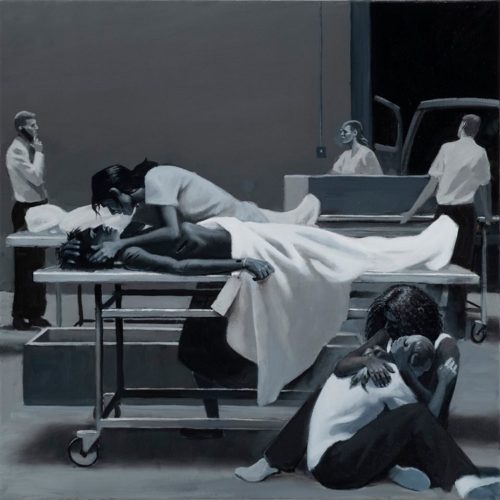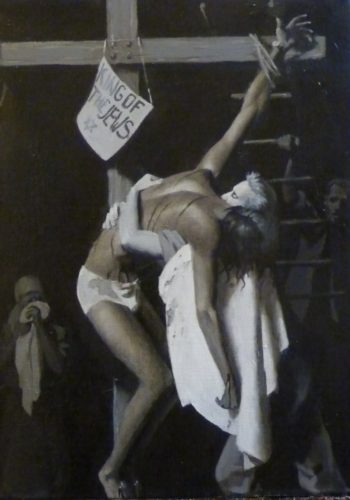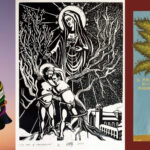Last Updated on April 12, 2025 by Kittredge Cherry
“They took the body of Jesus, and bound it in linen cloths with the spices, as is the burial custom.” — John 19:40 (RSV)
A mother mourns her dead son in “Jesus is Buried” from “The Passion of Christ: A Gay Vision,” a series of 24 paintings by Douglas Blanchard. Mary leans over the body of Jesus, ready to kiss his ashen face goodbye. Crucifixion wounds are still visible on his wrists, feet, and side. An identification tag from a morgue is tied around his wrist. His corpse is bloodless and wrapped in a plain white shroud. The gravedigger shovels dirt from the grave where Jesus will be buried. A simple wooden coffin waits. The night is dark with city lights in the distance. The simple dignity of the scene conveys the deepest sorrow and the finality of death.

“Jesus is Dead (Lamentation)” from the new Large Passion series by Douglas Blanchard
This scene has special resonance during the global COVID-19 pandemic. Millions have died wordwide with massive social and economic disruption. Many events were cancelled, including the opening exhibition of Blanchard’s new Passion series planned for Easter 2020 in New York City. The completed set of 20 paintings was finally exhibited in September 2023 at the Revelation Gallery at St. John’s in the Village in New York City.
Blanchard’s new gay Passion features a darker, racially indeterminate Jesus who lives in a monochrome world until his resurrection. The lamentation painting shows Mary grieving over her son’s corpse in a barren hospital setting that looks eerily similar to televised news reports of coronavirus patients who currently crowd into hospitals — even though Blanchard finished painting it shortly before the pandemic began.
Like Blanchard, other artists have put the death of Jesus into their own contemporary context with nontraditional Christ figures. Kehinde Wiley, the African American artist who painted President Obama’s official portrait for the Smithsonian, updates the 1522 classic “The Dead Christ in the Tomb” by Hans Holbein of Germany. In Wiley’s version, a modern young black man in shorts stretches prone on the slab.
The burial of Jesus is described in all four gospels and discussed in the earliest summaries of the Christian message in the epistles. His burial has been important to Christians since Biblical times because it confirms that Jesus really died, thus laying the groundwork for the miracle of his resurrection. The Bible reports that Jesus was laid in a rock-hewn tomb with the help of his disciple Joseph of Arimathea, while Mary Magdalene and “the other Mary” watched.
 The subject is common in art history, where it is known as the Lamentation. A notable version was painted by Italian Renaissance artist Andrea Mantegna, whose Lamentation showed Jesus’ foreshortened cadaver on a slab, wounded feet first. Like most scenes from the Passion, the Lamentation was not depicted at all until the 11th century, and then proliferated in the Renaissance and Baroque periods.
The subject is common in art history, where it is known as the Lamentation. A notable version was painted by Italian Renaissance artist Andrea Mantegna, whose Lamentation showed Jesus’ foreshortened cadaver on a slab, wounded feet first. Like most scenes from the Passion, the Lamentation was not depicted at all until the 11th century, and then proliferated in the Renaissance and Baroque periods.
The last two scenes in the traditional Stations of the Cross show Jesus being taken down from the cross and buried in his tomb. Nothing touched viewers more deeply than a mother’s grief, so artists gave an increasingly central role to Mary. They focused on the heart-rending moment when the bereaved mother cradles her son’s dead body in a specific type of Lamentation known as a Pieta (Italian for “pity”). The most famous Pieta is the sculpture by Michelangelo at St. Peter’s Basilica in Vatican City. It has become one of the Passion’s most iconic scenes, often copied or parodied to make a point.
Modern artists have used his Pieta composition to express other forms of grief. Some relocate it or switch the characters to make a personal or political statement. Black women grieve over the corpse of a black Jesus beneath the cross in the 1944 “Lamentation” by African American artist William H. Johnson. Others, such as German Surrealist Max Ernst, use it to depict the unconscious mind. He replaced Jesus and Mary with a self-portrait of the artist held by his stern, staunchly Catholic father in “Pieta or Revolution by Night.”
Some versions address the impact of AIDS and homophobia on LGBT people. The magnitude of the AIDS death toll was made worse by Christians who saw the disease as God’s punishment for homosexuality. In her famous Ecce Homo series, Swedish artist Elisabeth Ohlson Wallin photographed an emaciated gay AIDS patient cradled by a leather bar employee in the AIDS ward of a Stockholm hospital. American painter Matthew Wettlaufer’s “Pieta” shows a gay man at the bedside of his dying lover while bombs drop and a blanket lists the names of war-torn countries and gay-bashing victims. “Stations of the Cross: The Struggle for LGBT Equality” by Mary Button weaves together past and present to make deadly comparisons: Jesus is taken down from his cross beside a map of states banning same-sex marriage, and LGBT youths driven to suicide watch as he is laid in his tomb.
Blanchard’s understated Lamentation is closely related to the next two paintings in his gay vision of the Passion. All three images use dark tones to convey Jesus’ experiences with death and the underworld. Life, not death, was Jesus’ focus, and he gave mixed messages about mourning the dead. He promised comfort for those who mourn. He was so concerned about the welfare of his mother and his beloved disciple after his death that from the cross he declared them to be family for each other. But he did not have an overly sentimental attachment to family or funeral customs. He even ordered a disciple to skip his father’ funeral, saying, “Leave the dead to bury their own dead.”

“Station 13: Jesus is Taken Down from the Cross” by Douglas Blanchard
Blanchard painted a related scene with a darker-skinned Jesus for a Lenten series at the Church of St. Luke’s in the Fields, an Episcopal church in New York City’s Greenwich Village. Their Stations of the Cross series is all original artwork by St. Luke parishioners. Blanchard painted Station 13, the descent from the cross. His work is an oil on canvas measuring 22 by 16 inches.
The 13th Station shows the body of Jesus taken down from the cross and placed in the arms of his mother. The scene comes from tradition, not scripture, which only states that the body was given by request to Joseph of Arimathea for burial in his own tomb. It is known in art history as the “Descent from the Cross” or “Deposition of Christ.”
Blanchard’s version is monochrome with a contemporary dark-skinned Jesus being unceremoniously dropped into the arms of a soldier while his mother weeps in the background. It is posted on the church website with reflections by Anahi Galante and Julia Alberino.
Galante writes, “The dark skin of Jesus is a painful reminder of who gets killed in our society, and I think to myself: ‘Black lives matter!’ The dead, black body of Jesus comes to the forefront of the painting, and the white spectral figure of the mother moves to a second plane.”
Collection of Robert Wilder Nightingale
“Even the darkness is not dark to you.” — Psalm 139:12 (Inclusive Language Lectionary)
Endless rows of corpses fill a vast black space in “Jesus Among the Dead.” Even in death, Jesus is not separate from humanity. He lays with the stink, the dead bodies, and the skeletons — a common man in a common grave. Jesus can be identified by his crucifixion wounds. His corpse only stands out because it has not begun to decompose. He glows just slightly with a sick luminescence. Jesus just lies there, not judging, not fixing, not rescuing. He is simply present with people in the darkest state of being. This must be hell, or some human holocaust. Perhaps there is no difference.
At first glance Blanchard’s painting looks almost entirely black. The painting challenges viewers to keep looking until their eyes adjust to the lack of light. Then shapes and meanings emerge from the shadows to offer uncomfortable wisdom from the depths. Mystical traditions say there power to be gained by descent into the dark netherworld of dreams, intuition, death, and the unknown. In the mass grave Jesus is fulfilling Isaiah’s prophecy that God’s suffering servant would be buried with “transgressors” and “the wicked.” The black void conveys utter despair over the meaninglessness of life.
The Bible doesn’t tell what Jesus experienced in the interlude between crucifixion and resurrection, but artists and theologians of the past were quick to fill the void. The Apostle’s Creed clearly states, “He descended into hell,” or in another translation, “He descended to the dead.” Artists traditionally show Jesus leading an uprising in hell. The subject is traditionally known as the Harrowing of Hell, when Christ descends to hell or limbo to rescue the souls held captive there since the beginning of time. The next painting, “Jesus Rises,” makes even more direct references of the Harrowing of Hell. Some churches mark the event on Holy Saturday by stripping their altars bare or covering them with black cloth.
Blanchard takes the dead Jesus to a whole new level. His Jesus is not triumphantly waking the deceased, at least not yet. He stays dead in the afterlife, sharing the reality of human powerlessness. A few artists, notably German Renaissance painter Hans Holbein, depicted the corpse of Jesus with gruesome realism. But Blanchard’s monolithically black visual vocabulary in “Jesus Among the Dead” has more in common with modern art, photography, and philosophy. He based the composition on documentary photographs of the Holocaust, especially photos of bodies laid out in long rows after the liberation of the Nazi concentration camp at Nordhausen in 1945. New Mexico gallery owner Robert Wilder Nightingale singled out “Jesus Among the Dead” to purchase for his private collection when it was exhibited in Taos in 2007. “To me the work is haunting. A nightmare I wish never to see happen in reality,” he explained.
This is one of the most difficult paintings in Blanchard’s Passion series because it’s hard to see anything at all in the gloom. It resembles the all-black abstract paintings done by American artist Ad Reinhardt in the 1960s. Reinhardt claimed that these were the “last paintings that anyone can paint” — a fitting concept for Jesus among the dead. Reinhardt painted them in the era when the “God is dead” theological movement announced that there was no longer any cultural relevance for the idea of transcendent God acting in human history. Another precedent for Blanchard’s black image is the Vietnam Memorial Wall in Washington DC. Inscribed with a seemingly endless list of war casualties, the memorial stretches like a long, black gash in the earth.
The most significant memorial for many in the LGBT community is the Names Project AIDS Memorial Quilt. More than 48,000 handmade panels commemorate those who died of AIDS, including thousands of gay men. Before effective treatments were developed in the 1990s, AIDS was stigmatized as the “gay plague” and the LGBT community felt like a war zone as thousands died. Fundamentalists preached that AIDS was God’s punishment for homosexuality and President Reagan kept silent. Lovers, friends, and family learned to show they cared by staying present with the dying. Meanwhile they advocated change through groups such as ACT UP, whose motto was “Silence = Death.”
The AIDS pandemic is part of a larger queer holocaust. Many LGBT people experience a kind of living death, trapped in the private hell of the closet. Some have wished themselves dead and even taken their own lives. Those who wore the pink triangle were exterminated in Nazi death camps. The tragic history of church-approved persecution for homosexuality stretches back to the 13th century, when the first “sodomites” were burned at the stake. In Blanchard’s vision, Jesus rests with them in the ashes.
There are many hells and many types of limbo in which people are trapped neither fully alive nor dead. For example, the US Supreme Court overturned state sodomy laws in 2003, but same-sex marriage is still illegal in almost every state, leaving most LGBT people to exist in a non-quite-legal limbo.
___
Next: Day 8: Jesus rises, appears to Mary and friends, and more
or see the whole series “The Passion of Christ: A Gay Vision.”
The Passion series features 24 paintings by Douglas Blanchard, with text by Kittredge Cherry. It is also available as a book and prints.
Donate now to the 2025 Palm Sunday/Holy Week offering to support this series.
___
Top image credit:
16. Jesus is Buried (from The Passion of Christ: A Gay Vision) by Douglas Blanchard
___
This article was originally published on Q Spirit in April 2017, expanded with new material over time, and most recently updated on April 12, 2025.
Scripture quotations are from Revised Standard Version of the Bible, copyright © 1946, 1952, and 1971 National Council of the Churches of Christ in the United States of America. Used by permission. All rights reserved.
Scripture quotations are also from the Inclusive Language Lectionary (Year C), copyright © 1985-88 National Council of the Churches of Christ in the United States of America.
Copyright © Kittredge Cherry. All rights reserved.
Qspirit.net presents the Jesus in Love Blog on LGBTQ spirituality.























Buona Pasqua, Sorella Kittredge: Pace ed Unità!
[Translation from Italian: “Happy Easter, Sister Kittredge: Peace and Unity!”]
Happy Easter to you too!
So so moving. As a gay woman of 67 years this has brought me to my knees.
So poignant. The Resurrection is a reminder of mortality–and of our terrible need to care for one another.
I think Doug Blanchard’s project is profoundly meaningful.
Happy Easter, Kitt! I love how you put Blanchard’s paintings in the context of art history and world events, bringing out the layers of symbolism.
I’m glad that you appreciate how I put art into the context of current affairs. It took extra time and effort to add how this painting relates to the current COVID-19 pandemic, and I wondered who would notice. But now I know that YOU noticed. Thanks for commenting and happy Easter!